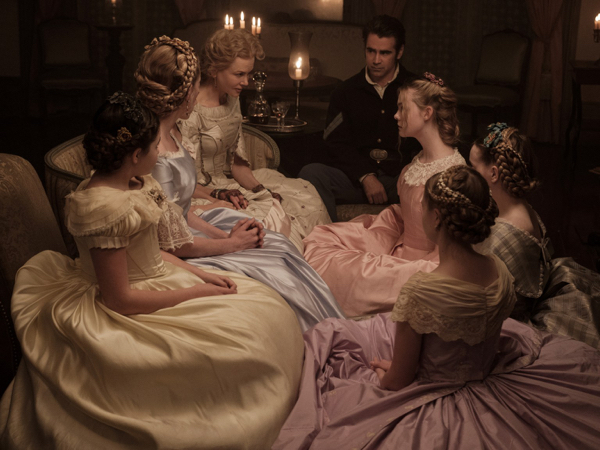Movie review by Greg Carlson
For her work on “The Beguiled,” Sofia Coppola was awarded the best director honor at the Cannes Film Festival. She is only the second woman in that particular derby to do so in the festival’s seven decades, following Yuliya Solntseva’s 1961 nod for “The Chronicle of Flaming Years.” The title of Solntseva’s film works well as a critique of the gender imbalance at both Cannes and in the film industry in general, so it is no surprise that a great deal of the writing on Coppola’s feature focuses on issues of femininity, womanhood, and sexuality.
Set during the Civil War, “The Beguiled” was first a 1966 novel by Thomas Cullinan, narrated in turns by the eight females who reside at a boarding school near a skirmish that produces wounded Sixty Sixth New York Union Corporal John McBurney, a native of Ireland with a silver tongue to match his home country’s finest talkers. Incapacitated by a mangled leg that will figure heavily in the ensuing suspense, McBurney (played by Colin Farrell) is both beguiled and beguiler, casting a heady spell on the household. The novel cranks up the secrets and lies to a level of feverish intensity. It is weirder, richer, and much more satisfying than either movie adaptation.
Basing her script on the book as well as the screenplay for the 1971 Clint Eastwood vehicle directed by Don Siegel, Coppola almost always aligns with the latter. Most obviously, she retains the Siegel film’s device of combining two of the novel’s key characters into one. Edwina, played here by Kirsten Dunst, is a student but retains key elements of Harriet Farnsworth, the sister of headmistress Martha (Nicole Kidman). One of the novel’s great pleasures blossoms from the increasingly antagonistic relationship between the bitter and competitive siblings, and the new film version might have been refreshed and invigorated had it restored that key dynamic.
More attention has been paid to the troubling decision to eliminate Matilda Farnsworth, a slave owned by Martha (and also to skip dealing with the issues of a mixed race character who “passes” as white). Renamed Hallie and portrayed by Mae Mercer in the Eastwood film, Matilda is indispensable in Cullinan’s telling of the tale. Coppola’s erasure, which has been called out as whitewashing in Slate, Teen Vogue, the Root, the Mary Sue, the Washington Post, and scores of other outlets, emerges as only one of the movie’s liabilities, but it is the most egregious.
As Charline Jao asserts in her excellent essay on “The Beguiled,” “the ‘Southern belle,’ especially, is a figure that romanticizes the economic prosperity that rises from slave labor — she cannot exist without the slave. Their so-called ‘proper’ femininity cannot be separated from that of the black woman, as invisible as she is in the film.” Jao goes on to a nuanced assessment accounting for the film’s strengths without excusing its weaknesses. Her comments, like the comments of Clarkisha Kent, illuminate a problematic pattern that stretches far beyond the filmography of talented Oscar-winner Coppola. Unfortunately, Coppola’s Cannes victory will likely be a mostly hollow one; “The Beguiled” is nowhere near her strongest work and will be chiefly remembered for what it didn’t include rather than for what it did.
